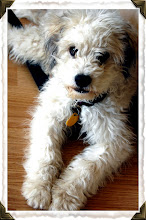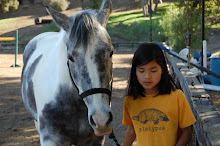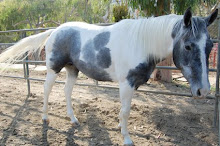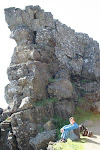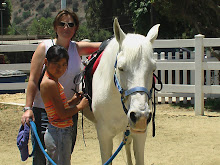April 20, 2009
Tools for Training
Speaking of dogs that pull (see below: "Durham Dog Training"), one of the best dog training tools I've come across recently are headcollars designed specifically for reducing pulling. These collars were designed by a horse trainer who realized that the best way to lead an animal is from the head, not the throat or neck area. Large, powerful animals like horses and camels can be safely led and directed with head halters. Why not dogs?
Some dogs pull because of inadequate training, but many dogs pull as a result of their breed. Huskies, Malamutes, Bully breeds, Akitas, and even hunting dogs tend to pull as a result of instinct, desire, and an overwhelming need to move forward and pursue prey. So, rather than getting into a pulling match or causing pain or even injury to a dog's neck, why not try a different kind of collar? I've used the Halti brand collar, and it works well, but some dogs can get out of it or pull it off with their paws. I've heard good things about the Gentle Leader Headcollar, and will field test it soon.
Whatever headcollar you choose, don't forget to slowly acclimatize your dog to the new system. Most dogs will not feel comfortable right away with a band around their nose, but with treats and repetition, they will get used to it! The beauty of these collars is that they are self-correcting: each time a dog pulls, it feels pressure across it's nose and the back of its neck, and reacts by slowing down to release the pressure. This is a completely humane, pain-free system that mimics behavior in the wild. Wolves will gently put pressure on the snout and back of the neck of any pack member that is asserting too much leadership, like trying to pull ahead of the pack! Most dogs will respond to the pressure by stopping or slowing down, and will learn to stop pulling without being forced, choked, or yanked.
No matter what type of collar or equipment you use, don't forget to keep training your dog!Reward the non-pulling behavior with positive reinforcement (allow sniffing, moving forward, praise, treats) and NEVER reward pulling. Allowing your dog to pull is self-rewarding to the dog. In other words, each and every time a dog pulls and is allowed to sniff or keep walking, the dog is getting a reward for pulling. Remember to stop and do not move forward unless and until the dog is not pulling on the leash or charging ahead.
Train your dog with repetition, positive reinforcement and patience. You will be rewarded with a happy, healthy, cooperative member of the pack. Enjoy!
Some dogs pull because of inadequate training, but many dogs pull as a result of their breed. Huskies, Malamutes, Bully breeds, Akitas, and even hunting dogs tend to pull as a result of instinct, desire, and an overwhelming need to move forward and pursue prey. So, rather than getting into a pulling match or causing pain or even injury to a dog's neck, why not try a different kind of collar? I've used the Halti brand collar, and it works well, but some dogs can get out of it or pull it off with their paws. I've heard good things about the Gentle Leader Headcollar, and will field test it soon.
Whatever headcollar you choose, don't forget to slowly acclimatize your dog to the new system. Most dogs will not feel comfortable right away with a band around their nose, but with treats and repetition, they will get used to it! The beauty of these collars is that they are self-correcting: each time a dog pulls, it feels pressure across it's nose and the back of its neck, and reacts by slowing down to release the pressure. This is a completely humane, pain-free system that mimics behavior in the wild. Wolves will gently put pressure on the snout and back of the neck of any pack member that is asserting too much leadership, like trying to pull ahead of the pack! Most dogs will respond to the pressure by stopping or slowing down, and will learn to stop pulling without being forced, choked, or yanked.
No matter what type of collar or equipment you use, don't forget to keep training your dog!Reward the non-pulling behavior with positive reinforcement (allow sniffing, moving forward, praise, treats) and NEVER reward pulling. Allowing your dog to pull is self-rewarding to the dog. In other words, each and every time a dog pulls and is allowed to sniff or keep walking, the dog is getting a reward for pulling. Remember to stop and do not move forward unless and until the dog is not pulling on the leash or charging ahead.
Train your dog with repetition, positive reinforcement and patience. You will be rewarded with a happy, healthy, cooperative member of the pack. Enjoy!
Durham Dog Training
I just got back from visiting my nephews in Durham, NC. Leo and Oliver are seven year-old twins and budding animal trainers. Both of them love horses and are curious to know more about training them. After a visit to a Wyoming Dude Ranch last year, they dream about living and working with horses someday. Because I didn't bring my horses with me to Durham, we focussed on learning how to train their dog, Romey. Romey is a wonderful dog, smart and loyal and affectionate. But she has a very strong urge to pull, and at one point she dragged Leo into the street, endangering both of them. I took the leash and after a few protests, explained that Romey needed some training in order to make it safer for them to take her on walks.
My nephews were eager to learn, and so with their enthusiasm and willingness making it easy and fun, I gave them an hour-long training session as we walked Romey to the local ice cream parlor and home again. We didn't have any dog treats, and the pet store was closed, so I had to make do with positive reinforcement of the non-food kind. Holding the leash in my hand for safety, I asked Leo to keep his hand gently touching the leash, close to Romey's collar. Each time Romey pulled on the leash, or walked ahead of either Leo or Oliver, I asked the boys to stop immediately. Each time Romey pulled or got ahead of them, they stopped in their tracks and stood still.
Romey responded by stopping as well, because she is very bonded to them, and doesn't want to leave her "pack" behind. She thinks that it is her job to lead, to take the alpha position when walking, because she hasn't learned or been taught anything else. Each time she's taken for a walk, she charges ahead, and is rewarded by being given access to sniffing, moving in front of her humans, and deciding for herself where she wants to go and at what pace. So, it's natural that she thinks this is the way she's supposed to behave. Romey has been "taught" that pulling is OK.
What my nephews and I were able to teach her, in one short training session, was that we wanted something else from her, and that she would be rewarded only for that behavior, but never rewarded for pulling. The reward in this case was the ability to move forward, and to sniff. Each time the twins stopped, Romey caught on more and more. She figured out that her job was to walk side by side with them, and not to pull or move ahead. When we got to the ice cream parlor, I waited outside with Romey and asked for calm behavior and a sit. Leo and Oliver wanted to train her to sit on command, and I told them we could try!
The first time I asked for a sit, Romey looked at me with a solid alpha stare and kept standing. Instead of repeating the voice command, I turned my attention away from her for a few seconds. When I turned back to her, she was looking at me with alertness and cooperation. I moved my hand over her head and towards her tail, said "Sit" once, and she did! This was rewarded with calm praise, and my attention. After a few minutes, I rewarded her for staying in the sit position, with more praise. Then I went inside the store, after firmly tying her leash to a bench, and asked her to "Stay." When my nephews and I came back outside, Romey was sitting calmly by the bench; she neither jumped up nor barked or wiggled when the boys sat down next to her. They were amazed, and couldn't believe that Romey could learn so quickly. It wasn't all that suprising: all Romey needed to know was that she didn't have to be in charge, that we humans would do that, and she could relax and just be with us.
Next, I asked the twins to sit calmly and not give Romey too much attention. Let's see how Romey reacts if we talk to each other, don't interact with her, and just let her be near us. Leo and Oliver were up for it, so we talked awhile, and something beautiful happened: Romey let out a deep sigh, her body and manner visibly relaxing, and she lay down next to her beloved boys. What a wonderful sight: my nephews happily eating ice cream with their big, gentle dog resting calmly at their feet.
Just an hour earlier, Romey had been filled with agitation, energy and restlessness. She had pulled and dragged her walker down the street and even into the street, stopped constantly to sniff along the way, and acted like the leader of the pack. Although she thought this was her job, it was causing problems and endangering her and her humans. Now, she could relax and be a dog, without the pressures of having to lead. She stayed close to the twins on the way home, and pulled and charged ahead only once or twice. We allowed her to sniff only when she was walking next to them, and not pulling. She learned to stop and sit at curbs, and the boys learned to decide when to cross, allowing Romey to move forward into the intersection only when they had moved forward first. It was truly amazing! And all without food treats, just the positive reinforcement of being given the reward of walking with her pack.
Of course, it will take many more repetitons and training sessions with Romey to cement this good behavior. Leo and Oliver are eager to continue her training, and I have encouraged them to keep working with her. And they will always need an adult to walk with them and hold the leash, as they continue Romey's training. But it was a terrific example of how quickly most dogs can learn, and how effectively you can train with clear, consistent commands and tangible rewards. Romey was such a willing and cooperative student, and that sigh of relief when she lay down was a powerful reminder of how much stress dogs can and do carry, if they are allowed (or even encouraged) to be the alpha.
With some consistent training and a calm leadership style, you can let your dog be a member of the pack, without the pressures and pitfalls of having to lead. Both of you will enjoy the relaxed, happy dog that results. Good luck, Romey! And much love and thanks to my nephews and future animal trainers/ranch owners, Oliver and Leo Egger, of Durham, NC. : )
My nephews were eager to learn, and so with their enthusiasm and willingness making it easy and fun, I gave them an hour-long training session as we walked Romey to the local ice cream parlor and home again. We didn't have any dog treats, and the pet store was closed, so I had to make do with positive reinforcement of the non-food kind. Holding the leash in my hand for safety, I asked Leo to keep his hand gently touching the leash, close to Romey's collar. Each time Romey pulled on the leash, or walked ahead of either Leo or Oliver, I asked the boys to stop immediately. Each time Romey pulled or got ahead of them, they stopped in their tracks and stood still.
Romey responded by stopping as well, because she is very bonded to them, and doesn't want to leave her "pack" behind. She thinks that it is her job to lead, to take the alpha position when walking, because she hasn't learned or been taught anything else. Each time she's taken for a walk, she charges ahead, and is rewarded by being given access to sniffing, moving in front of her humans, and deciding for herself where she wants to go and at what pace. So, it's natural that she thinks this is the way she's supposed to behave. Romey has been "taught" that pulling is OK.
What my nephews and I were able to teach her, in one short training session, was that we wanted something else from her, and that she would be rewarded only for that behavior, but never rewarded for pulling. The reward in this case was the ability to move forward, and to sniff. Each time the twins stopped, Romey caught on more and more. She figured out that her job was to walk side by side with them, and not to pull or move ahead. When we got to the ice cream parlor, I waited outside with Romey and asked for calm behavior and a sit. Leo and Oliver wanted to train her to sit on command, and I told them we could try!
The first time I asked for a sit, Romey looked at me with a solid alpha stare and kept standing. Instead of repeating the voice command, I turned my attention away from her for a few seconds. When I turned back to her, she was looking at me with alertness and cooperation. I moved my hand over her head and towards her tail, said "Sit" once, and she did! This was rewarded with calm praise, and my attention. After a few minutes, I rewarded her for staying in the sit position, with more praise. Then I went inside the store, after firmly tying her leash to a bench, and asked her to "Stay." When my nephews and I came back outside, Romey was sitting calmly by the bench; she neither jumped up nor barked or wiggled when the boys sat down next to her. They were amazed, and couldn't believe that Romey could learn so quickly. It wasn't all that suprising: all Romey needed to know was that she didn't have to be in charge, that we humans would do that, and she could relax and just be with us.
Next, I asked the twins to sit calmly and not give Romey too much attention. Let's see how Romey reacts if we talk to each other, don't interact with her, and just let her be near us. Leo and Oliver were up for it, so we talked awhile, and something beautiful happened: Romey let out a deep sigh, her body and manner visibly relaxing, and she lay down next to her beloved boys. What a wonderful sight: my nephews happily eating ice cream with their big, gentle dog resting calmly at their feet.
Just an hour earlier, Romey had been filled with agitation, energy and restlessness. She had pulled and dragged her walker down the street and even into the street, stopped constantly to sniff along the way, and acted like the leader of the pack. Although she thought this was her job, it was causing problems and endangering her and her humans. Now, she could relax and be a dog, without the pressures of having to lead. She stayed close to the twins on the way home, and pulled and charged ahead only once or twice. We allowed her to sniff only when she was walking next to them, and not pulling. She learned to stop and sit at curbs, and the boys learned to decide when to cross, allowing Romey to move forward into the intersection only when they had moved forward first. It was truly amazing! And all without food treats, just the positive reinforcement of being given the reward of walking with her pack.
Of course, it will take many more repetitons and training sessions with Romey to cement this good behavior. Leo and Oliver are eager to continue her training, and I have encouraged them to keep working with her. And they will always need an adult to walk with them and hold the leash, as they continue Romey's training. But it was a terrific example of how quickly most dogs can learn, and how effectively you can train with clear, consistent commands and tangible rewards. Romey was such a willing and cooperative student, and that sigh of relief when she lay down was a powerful reminder of how much stress dogs can and do carry, if they are allowed (or even encouraged) to be the alpha.
With some consistent training and a calm leadership style, you can let your dog be a member of the pack, without the pressures and pitfalls of having to lead. Both of you will enjoy the relaxed, happy dog that results. Good luck, Romey! And much love and thanks to my nephews and future animal trainers/ranch owners, Oliver and Leo Egger, of Durham, NC. : )
Subscribe to:
Posts (Atom)
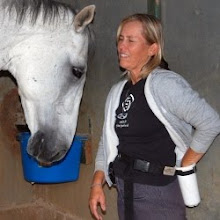.jpg)
